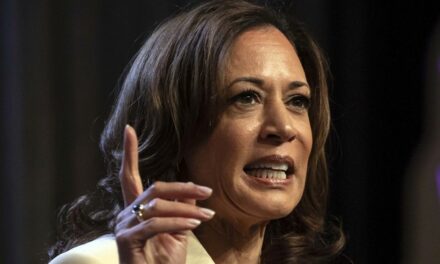We support our Publishers and Content Creators. You can view this story on their website by CLICKING HERE.

The national polling is also very important for the Senate races. There are now three scenarios, or tiers, for the polling. Tier 1 polls have Kamala Harris up by more than 3 points, including Reuters, Morning Consult, CBS, NBC, and Yahoo. Tier 2 polls have her and Donald Trump in a statistical dead heat, including Quinnipiac, CNN, Rasmussen, Fox, Harris X, and Siena. Tier 3 has Trump up by 3 or more, and is Gallup and Atlas Intel. (Gallup refuses to give us actual head-to-head numbers, because they stopped doing that in 2012. However, it can be figured out from what they do give us.)
Advertisement
These three tiers can’t all be correct.
ANALYSIS: Returning to the Senate Races
While my buddy Cameron fears otherwise, I find the Tier 1 polls to be patently ridiculous. First, as I have belabored before, the economy is bad, the border is bad, and the world chaos is bad. And all of if was better when Donald Trump was in office, just four years ago (excepting the COVID year, which swing voters don’t blame him for). Historically speaking, there have been three recent presidential years when these same/similar problems existed: 1968, 1980, and 2008 (although maybe not the border problem in the first two). In all of these races, the out-party won. Only one race was even close; in 1968, a strong Democrat was able to distance himself from his president on a burning issue (Vietnam) and only narrowly lost the popular vote.
Meanwhile, Harris has run by pretending to NOT be a part of the incumbent administration, by avoiding any real issues except abortion, by flip flopping on her left-wing record, and also by NOT being Donald Trump, who she continues to portray as the devil. I don’t believe this is a good strategy for appealing to swing voters, who know that she is the vice president, have noticed her lack of content, are learning about her left-wing record, and have heard endlessly in a very exaggerated fashion about Trump’s foibles for a decade now.
Advertisement
Second, these Tier 1 polling numbers are suspect because, as I have said before:
I know there has been speculation that this year, the public pollsters are doing their best to get the numbers right. However, in my experience, public pollsters are people too, who don’t like to learn from their mistakes, often have their own biases that they can’t recognize, and sometimes are actually interested in pushing an agenda as well. Plus, in this situation, there are some other reasons why there might be a significant problem – see the response bias problem that public polls won’t spend the money to fix. The campaign polling is much, much better (than public polling) because their livelihood depends on it, and as a result, the campaigns both know that it is a much tougher race for Kamala Harris to win. We know this because prominent Democrat consultants David Axelrod and James Carville, who have access to the Harris campaign numbers, have told Democrats to be cautious in their irrational exuberance.
Now, we also know these Tier 1 polls can’t be true because Democrat Senate candidate Rep. Elissa Slotkin of Michigan has admitted that Harris is “underwater” in her private campaign polling in Michigan, while the RCP polling average has Harris as the favorite, up 1.4 percent. And Michigan, of course, is also slightly more Democrat than the nation as a whole.
Advertisement
So, this leaves us with either the Tier 2 or 3 polls depicting the correct environment. Atlas Intel, Gallup and Siena have excellent reputations; the other polling firms are more mixed.
If the race ends with a close popular margin, like the Tier 2 polls indicate, then it could be similar to what happened in 1968. That year, the out-party Republican won 43.4 percent of the presidential vote to 42.7 percent for the Democrat vice president (with a strong third-party candidate taking from both sides), and a pick-up of 5 Senate Republican seats. But that same year, the GOP did win a convincing electoral college victory. And indeed, as I have said many times before, the Republicans have the edge in the Electoral College this year as well. If the race ends in a dead heat, Donald Trump will carry most of the battleground states and win the presidency.
If the race ends with a solid Trump popular lead, like the Tier 3 polls indicate, then it could be similar to what happened in 1980 and 2008. In 1980, the out-party Republican won the presidency 51 percent to 41 percent, and the GOP picked up 12 Senate seats. In 2008, the out-party Democrat won 53 percent to 46 percent, and the Democrats won 8 Senate seats.
But in all three of these elections, the out-party won big in the U.S. Senate. They picked up 5 in 1968, 12 in 1980, and 8 in 2008. Further, in these and all other Senate races, the party with the momentum (the “Big Mo”) wins a disproportionate number of the Senate elections. And as we may remember from the 1980 elections, many of these elections break late, and the final result is not correctly predicted by the polling before the actual election.
Advertisement
On November 3, 1980, the day before the election, Time Magazine’s poll claimed that incumbent Democrat President Jimmy Carter had a 42 percent to 41 percent lead over Republican Ronald Reagan, with 12 percent for Independent John Anderson. It also reported, “Democrats are almost certain to retain control of both chambers… Leaders of both parties predict that the Republicans will score a net gain of … two or three in the Senate.” That same day, Newsweek’s poll had Carter with a similar slight edge over Reagan, 41 percent to 40 percent, with 10 percent for Anderson. It also stated that “a scouting report foresaw prosperity for (the Republican) party as well – a net pickup of perhaps 4 or 5 seats in the Senate…” Newsweek also produced a chart on individual Senate races, with their rankings. However, the very next day, Ronald Reagan crushed Jimmy Carter by 51 percent to 41 percent of the national vote, with 7 percent going to Anderson. Reagan’s large margin of victory gave a huge boost to Republican Senate candidates, allowing them to flip an almost unprecedented net of 12 Democrat seats.
That is why I said my “baseline” prediction for the GOP pick-up in the Senate is 5.
It could be much more, as history shows.

 Conservative
Conservative  Search
Search Trending
Trending Current News
Current News 





